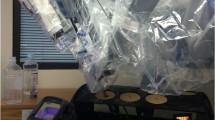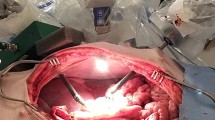Abstract
Background
Electromagnetic coupling can occur between the monopolar “Bovie” instrument and other laparoscopic instruments without direct contact by a phenomenon termed antenna coupling. The purpose of this study was to determine if, and to what extent, radiofrequency energy couples to other common laparoscopic instruments and to describe practical steps that can minimize the magnitude of antenna coupling.
Methods
In a laparoscopic simulator, monopolar radiofrequency energy was delivered to an L-hook. The tips of standard, nonelectrical laparoscopic instruments (either an unlit 10 mm telescope or a 5 mm grasper) were placed adjacent to bovine liver tissue and were never in contact with the active electrode. Thermal imaging quantified the change in tissue temperature nearest the tip of the telescope or grasper at the end of a 5 s activation of the active electrode.
Results
A 5 s activation (30 watts, coagulation mode, 4 cm separation between instruments) increased tissue temperature compared with baseline adjacent to the grasper tip (2.2 ± 2.2 °C; p = 0.013) and telescope tip (38.2 ± 8.0 °C; p < 0.001). The laparoscopic telescope tip increased tissue temperature more than the laparoscopic grasper tip (p < 0.001). Lowering the generator power from 30 to 15 Watts decreased the heat generated at the telescope tip (38.2 ± 8.0 vs. 13.5 ± 7.5 °C; p < 0.001). Complete separation of the camera/light cords and the active electrode cord decreased the heat generated near the telescope tip compared with parallel bundling of the cords (38.2 ± 8.0 vs. 15.7 ± 11.6 °C; p < 0.001).
Conclusions
Commonly used laparoscopic instruments couple monopolar radiofrequency energy without direct contact with the active electrode, a phenomenon that results in heat transfer from a nonelectrically active instrument tip to adjacent tissue. Practical steps to minimize heat transfer resulting from antenna coupling include reducing the monopolar generator power setting and avoiding of parallel bundling of the telescope and active electrode cords.



Similar content being viewed by others
References
Nduka CC, Super PA, Monson JR, Darzi AW (1994) Cause and prevention of electrosurgical injuries in laparoscopy. J Am Coll Surg 179:161–170
Hulka JF, Levy BS, Parker WH, Phillips JM (1997) Laparoscopic-assisted vaginal hysterectomy: American Association of Gynecologic Laparoscopists’ 1995 membership survey. J Am Assoc Gynecol Laparosc 4:167–171
Feder BJ (2006) Surgical device poses a rare but serious peril. New York Times
IEEE ASC (2009) American National Standard Dictionary of Electromagnetic Compatibility (EMC) including electromagnetic environmental effects (E3). Institute of Electrical and Electronics Engineers (IEEE) Inc, Washington, DC
IEEE S (2005) IEEE Guide for instrumentation and control equipment grounding in generating stations. Institute of Electrical and Electronics Engineers (IEEE) Inc, Washington, DC
Montero PN, Robinson TN, Weaver JS, Stiegmann GV (2009) Insulation failure in laparoscopic instruments. Surg Endosc 24:462–465
Robinson TN, Pavlovsky KR, Looney H, Stiegmann GV, McGreevy FT (2010) Surgeon-controlled factors that reduce monopolar electrosurgery capacitive coupling during laparoscopy. Surg Laparosc Endosc Percutan Tech 20:317–320
Voyles CR, Tucker RD (1992) Education and engineering solutions for potential problems with laparoscopic monopolar electrosurgery. Am J Surg 164:57–62
Govekar HR, Robinson TN, Stiegmann GV, McGreevy FT (2011) Residual heat of laparoscopic energy devices: how long must the surgeon wait to touch additional tissue? Surg Endosc 25(11):3499–3502
Wu MP, Ou CS, Chen SL, Yen EY, Rowbotham R (2000) Complications and recommended practices for electrosurgery in laparoscopy. Am J Surg 179:67–73
Robinson TN, Barnes K, Govekar HR, Stiegmann GV, Dunn C, McGreevy FT (2012) Antenna coupling: a novel mechanism of radiofrequency electrosurgery complication: practical implications. Ann Surg (In press)
Abu-Rafea B, Vilos GA, Al-Obeed O, Al-Sheikh A, Vilos AG, Al-Mandeel H (2011) Monopolar electrosurgery through single-port laparoscopy: a potential hidden hazard for bowel burns. J Minim Invasive Gynecol 18:734–740
Disclosures
Edward L. Jones, Christina L. Dunn, Paul N. Montero, Henry R. Govekar, and Greg V. Stiegmann have no conflict of interest or financial ties to disclose. Thomas N. Robinson has received honoraria for teaching the topic of electrosurgery from ConMed Electrosurgery and Covidien. He has received education grants from Gyrus and Karl Storz Endoscopy, and a research grant from Medtronic, Inc. Jennifer R. McHenry is a current employee of Covidien.
Author information
Authors and Affiliations
Corresponding author
Rights and permissions
About this article
Cite this article
Jones, E.L., Robinson, T.N., McHenry, J.R. et al. Radiofrequency energy antenna coupling to common laparoscopic instruments: practical implications. Surg Endosc 26, 3053–3057 (2012). https://doi.org/10.1007/s00464-012-2312-6
Received:
Accepted:
Published:
Issue Date:
DOI: https://doi.org/10.1007/s00464-012-2312-6




